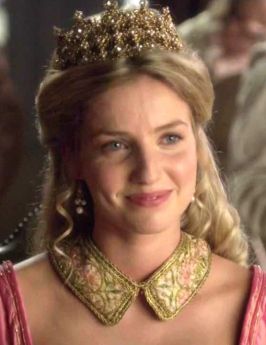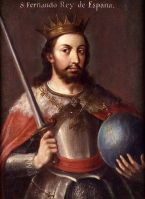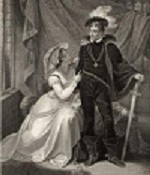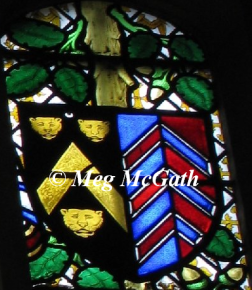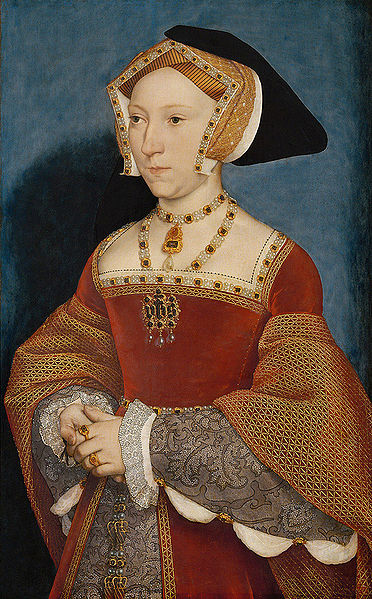Jane Seymour's
Ancestors
Click EasyEdit to add/edit this page (Don't see the EasyEdit button above? <a href="/#signin" target="_self">Sign in</a> or <a href="/accountnew" target="_self">Sign up</a>.) | <a class="external" href="http://www.youtube.com/watch?v=hvjaWL98gJE" rel="nofollow" target="_blank" title="David Starkey on William I of England">
</a>
The St Maur Family
Believed to have settled in England during the Norman conquest from the French town of St. Maur-sur-Loire, the family lived in relative obscurity as landowners and low noblility. <a class="external" href="http://www.s560.com/dokuwiki/annals" rel="nofollow" target="_blank">(More on the origins of St Maur.)</a> The family was settled in Monmouthshire, Wales in the 13th century. The original form of the name, which has been resumed by the dukes of Somerset since 1863, seems to have been St. Maur, of which William Camden says that Seymour was a later corruption. It appears that about the year 1240 Gilbert Marshal, Earl of Pembroke, assisted William St. Maur to wrest a place called Woundy (now Undy), near Caldicot in Monmouthshire, from the Welsh. Woundy and Penhow, at the latter of which he made his residence, were the property of Sir Richard St. Maur at the end of the 13th century, but they died from the family through the marriage of Sir Richard's great-great-granddaughter, the only child of John St. Maur, who died in 1359. John St. Maur's younger brother Roger married Cecily, one of the daughters and co-heiresses of John Beauchamp of Hache, Baron Beauchamp de Somerset (d. 1361), who brought to her husband the greater part of her father's extensive estates in Somersetshire, Devonshire, Buckinghamshire, and Suffolk. The eldest son of this marriage was Sir William St. Maur, or Seymour (for the later form of the name appears to have come into use about this date), who was an attendant on the Black Prince, and who died in his mother's lifetime, leaving a son Roger, who inherited the estates and added to them by his marriage with Maud, daughter of Sir William Esturmi of Wolf Hall, Wiltshire. |
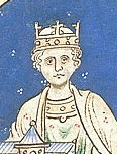
Henry II
King of England
(1133 - 1189)
great-grandson of William the Conqueror, was the first of the House of Plantagenet to rule England. Henry was the first to use the title "King of England" (as opposed to "King of the English"). His mother was the Empress Matilda, Holy Roman Empress, Queen of Germany and the first woman ruler of England.
| 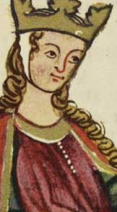
Eleanor of Aquitaine
(1122 - 1201)
ruler in her own right of Aquitaine, queen consort in France then England; queen mother in England.
| 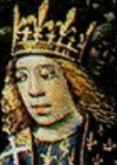
Louis VII
King of France
(1120 - 1180)
the son and successor of Louis VI "the fat" and Adelaide of Maurienne. He ruled from 1137 until his death. He was a member of the House of Capet. His reign saw the beginning of the long feud between France and England.
| 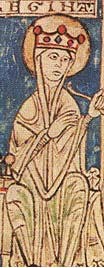 Henry II and Eleanor of Aquitaine had 8 children including: Henry II and Eleanor of Aquitaine had 8 children including:
John, King of England and Eleanor, Queen of Castile
(pictured right)
Jane Seymour had both siblings as ancestors.
Jane Seymour also descended from Marie of France, Countess of Champagne; daughter of Louis VII and Eleanor of Aquitaine.
Jane Seymour also descended from Henry's half-brother, Hamelin Plantagenet (de Warenne), the 5th Earl of Surrey who married Isabel de Warenne. Their daughter Adela would become mistress to her cousin, John of England and produce an illegitimate son named Richard. Through Isabel, Jane descended from Henry I of France.
Jane also supposedly descended from Henry II's brother, William Plantagenet, Count of Poitou and his mistress Cecily FitzPayne. Their daughter Edith would marry William de Windsor.
| 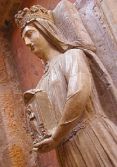
Berengaria
Queen of Castile and Leon
(1180 - 1246)
daughter of Eleanor of England, Queen of Castille
Mother of Ferdinand III | 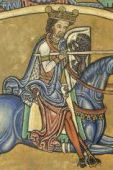
Alfonso IX
King of León and Galicia
(1171 – 1230)
Father of Ferdinand III
| 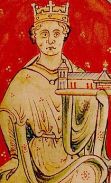
John
King of England
(1167 - 1216)
Father of Henry III and Richard Fitzroy
(ancestor of the
Stourton family by John's cousin Adela de Warenne)
| 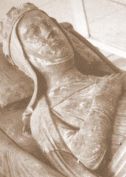
Isabella of Angoulême
(1188 - 1246)
Mother of Henry III
|
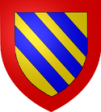
Joan Dammartin
Countess of Pontheiu
(c. 1220 - 1279)
She was the daughter of Simon of Dammartin, Count of Ponthieu and his wife Marie of Ponthieu, Countess of Montreuil. Her maternal grandparents were William IV of Ponthieu and Alys, Countess of the Vexin, daughter of Louis VII of France and Constance of Castile.
Mother of Eleanor of Castile
| Ferdinand III
King of Castile, Galicia & León
(1199 - 1252)
Also known as Ferdinand "the saint". He married firstly, Elisabeth of Hohenstaufen, daughter of Philip of Swabia and sister of Marie (the maternal grandmother of Blanche of Artois)
Father of Eleanor of Castile | 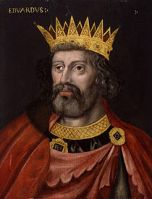
Henry III of Winchester
King of England
(1207 - 1272)
He was the first child king in England since the reign of Æthelred the Unready. England prospered during his reign and his greatest monument is Westminster (Palace of Westminster), which he made the seat of his government and where he expanded the Abbey as a shrine to Edward the Confessor.
Father of Edward I and Edmund Crouchback, 1st Earl of Lancaster
| 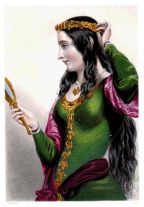
Eleanor of Provence
(c.1223 - 1302)
was the daughter of Ramon Berenguer V, Count of Provence and Beatrice of Savoy. Through her father she was a great-granddaughter of Alfonso II of Aragon and Sancha of Castile.
Mother of Edward I and Edmund Crouchback, 1st Earl of Lancaster
|
|
|
|
|
|
| | |
| 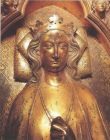
Eleanor of Castile
(1241-1290)
1st Wife of
Edward I
Daughter of Ferdinand III King of Castile, Galicia & León. Edward married Eleanor on October 18, 1254; at the Abbey of Las Huelgas, Burgos, Castile (Spain). She was dark haired and beautiful and they had 16 children, of which 7 survived into adulthood. Eleanor was buried in Westminster Abbey in London. To show his love for his departed wife, Edward erected 12 crosses along the route of her funeral procession from Lincoln to Westminster.
Mother of Edward II and Joan of Acre
| 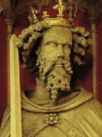
Edward I
King of England
(1239 - 1307)
Edward I was a tall man of six feet two inches (1.88m), with long arms and legs from which his nick-name, "Longshanks", was derived. His hair was black like his Provencal mother's, his complexion swarthy and his eyes fiery in anger. Edward spoke with a pronounced lisp, but possessed the Plantagenet temper in full measure.
Father of Edward II and Joan of Acre
| 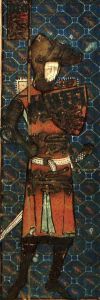
Edmund "Crouchback"
Prince of England
Plantagenet
(1245 - 1296
1st Earl of Lancaster
Prince of England
Younger Brother of King Edward I
Gained the title of
King Edmund of Sicily on 7 January 1254 and abdicated in 1263. It is believed his nickname is derived from "crossback" due to his participation in the Crusades. As a result of his marriage, Edmund was styled as Comte de Brie and Comte de Champagne in 1276
Father of Henry Plantagenet, 3rd Earl of Lancaster | 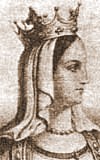
Blanche de Artois
(1248 -1302)
2nd wife of
Edmund "Crouchback"
Her paternal grandparents were King Louis VIII of France and Blanche of Castile. Her maternal grandparents were Henry II, Duke of Brabant and Marie of Hohenstaufen, daughter of Philip of Swabia.
She had previously married to King Henry of Navarre and had ruled after his death in 1274, as Queen Regent of Navarre in right of their daughter, Joan of Navarre.
Jane Seymour was a descendant of both husbands of Blanche. Through Henry she descended from Queen Regent Joanna of Navarre and Philip IV, King of France through their daughter who became Queen Isabella of England
(wife of Henry II).
Mother of Henry Plantagenet, 3rd Earl of Lancaster and
Joanna of Navarre
(mother of Isabella of France, Queen to Edward II)
|
|
|
|
|
|
|
|
| 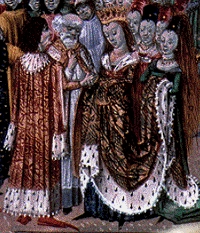 Edward II Edward II
King of England (son of Eleanor of Castile and Edward I) (1284-1327)&
Isabella of France (1295-1358)
Isabella was the daughter of
Philip IV King of France
and Joan I of Navarre (daughter of Blanche de Artois, above right)
Parents of
Edward III
| 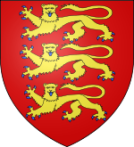
Lady Joan of Acre
Countess of Hertford
Princess of England
(1272 - 23 Apr 1307)
Joan was married twice. Her first husband was Gilbert de Clare, second Sir Ralph de Monthermer.
&

Gilbert de Clare
Earl of Gloucester
(2 September 1243 – 7 December 1295)
who was a powerful English noble. The couple was also the parents of Margaret de Clare
(mother of Margaret Audley,
*see Thomas Clifford, 6th Baron).
Parents of
Elizabeth Clare and Margaret de Clare
| 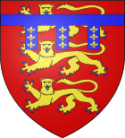
Sir Henry Plantagenet
3rd Earl of Lancaster
(1281 - 1345)
He was the son of Edmund 'Crouchback' Plantagenet and a nephew of Edward I.
&
Maud Chaworth
(1282 -1322)
Wealthy Heiress of Sir Patrick de Chaworth, Baron of Kidwelly and Isabella de Beauchamp.
Parents of Mary of Lancaster Plantagenet
and Maud of Lancaster Plantagenet
| 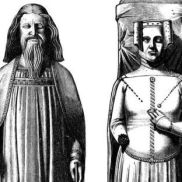 Edward III Edward III
King of England(1313-1377)
&
Phillipa of Hainault (1314-1369)
The daughter of William I, Count of Holland and Joan of Valois. Philippa descended from French royalty through her mother; through her father she was kin to Elizabeth Woodville's (Queen to Edward IV) family, the Counts of Luxembourg.
Parents of
Lionel of Antwerp
| 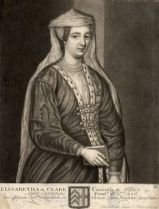
Elizabeth de Clare
Lady De Burgh
(16 September 1295 – 4 November 1360)
&
John de Burgh
(1286 – 18 June 1313)
was the son of Richard Óg de Burgh, 2nd Earl of Ulster and Margaret de Burgh.
As a descendant of the Earls of Ulster he was heir apparent, but he did not inherit the title as he died before his father. The title was passed on to his infant son, the 3rd Earl.
Parents of
William de Burgh, 3rd
Earl of Ulster | 
Lady Mary of Lancaster
Plantagenet
Baroness Percy
(1320 – 1 September 1362)
&
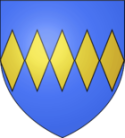
Henry Percy
3rd Baron Percy
(1320 - 18 May 1368)
Parents of
Henry Percy of Northumberland
|
| Lady Maud of Lancaster Plantagenet
Countess of Ulster
(c. 1310 – 5 May 1377)
Mother of
Lady Elizabeth de Burgh | William de Burgh
3rd Earl of Ulster
(1312–1333)
Father of
Lady Elizabeth de Burgh |
|
|
|
|
|
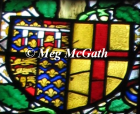
Lionel of Antwerp Prince of England
1st Duke of Clarence
Earl of Ulster (by right of his wife, Elizabeth) (1338-1368)
&
Father of
Lady Philippa Plantagenet
| Lady Elizabeth de Burgh suo jure
4th Countess of Ulster
Duchess consort of Clarence
(1332-1363)
She was the last of the senior legitimate line of the descendants of William de Burgh and therefore Countess of Ulster in her own right.
Mother of
Lady Philippa Plantagenet | 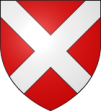
Margaret Neville
of Ros
Countess of Northumberland
(12 Feb 1329 - 12 May 1372)
Daughter of Sir Ralph Neville, 2nd Baron of Raby and his wife Lady Alice of Neville Audley.
Mother of
Henry "Hotspur" Percy
Husband of Elizabeth Mortimer
| 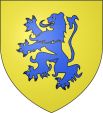
Henry Percy
1st Earl of Northumberland
Lord of Mann
(10 November 1341-
20 February 1408)
Father of
Henry "Hotspur" Percy
Husband of Elizabeth Mortimer
|
Lady Philippa Plantagenet
suo jure 5th Countess of Ulster
Countess of March
(16 August 1355 – 5 January 1382)
Mother of
Lady Elizabeth Mortimer
| Sir Edmund Mortimer
3rd Earl of March
(c. 1351-27 December 1381)
Son of Roger Mortimer, 2nd Earl of March and Philippa Montacute, daughter of the 1st Earl of Salisbury and his wife, Catherine Grandison.
Father of
Lady Elizabeth Mortimer
|
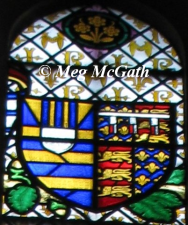 During her own lifetime, Philippa was the heiress presumptive to her first cousin Richard II, and would be displaced in the succession by any children of the king. After her death in 1382, her rights passed on to her son, Roger Mortimer, 4th Earl of March. When Richard resigned his crown without issue on 29 September 1399, the rightful heir was their grandson Edmund Mortimer, 5th Earl of March, whose father Roger had died the previous year. However, the throne was usurped by Richard and Philippa's first cousin, Henry Bolingbroke, an event that later precipitated the Wars of the Roses. As a result of her seniority in the line of succession to the throne of the Kingdom of England and her marriage into the powerful Mortimer family, her descendants through her great-grandson Richard Plantagenet, 3rd Duke of York eventually succeeded to the throne as the House of York under Edward IV and Richard III. During her own lifetime, Philippa was the heiress presumptive to her first cousin Richard II, and would be displaced in the succession by any children of the king. After her death in 1382, her rights passed on to her son, Roger Mortimer, 4th Earl of March. When Richard resigned his crown without issue on 29 September 1399, the rightful heir was their grandson Edmund Mortimer, 5th Earl of March, whose father Roger had died the previous year. However, the throne was usurped by Richard and Philippa's first cousin, Henry Bolingbroke, an event that later precipitated the Wars of the Roses. As a result of her seniority in the line of succession to the throne of the Kingdom of England and her marriage into the powerful Mortimer family, her descendants through her great-grandson Richard Plantagenet, 3rd Duke of York eventually succeeded to the throne as the House of York under Edward IV and Richard III. |
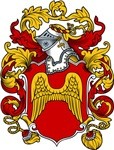
Sir Roger Seymour
of Evenswindon (1366-1420) &
Maud Esturmy
(1383-?)
through her marriage Wolfhall and Wiltshire were passed to the Seymour family, beginning with her son John.
Parents of
Sir John of Wolfhall Seymour
| Lady Elizabeth Mortimer
(1371-1417) &
Henry "Hotspur" Percy
Earl of Northumbland
Governor of Bordeaux (1364/66-1407)
Parents of
Lady Elizabeth Percy | Thomas Clifford
6th Baron Clifford
(1363-1393)
Son of Roger Clifford, 5th Baron and his wife Maud Beauchamp, daughter of Thomas Beauchamp, 11th Earl of Warwick and Katherine Mortimer.
&
Elizabeth Ros
Baroness Clifford
(1358-26 Mar 1424)
Daughter of Thomas De Ros, 5th Baron Ros of Hamlake and his wife Beatrice Stafford, Countess of Desmond, daughter of Ralph Stafford, 1st Earl Stafford and Margaret Audley, Baroness Audley (daughter of Margaret de Clare).
Parents of
John Clifford, 7th Baron
|
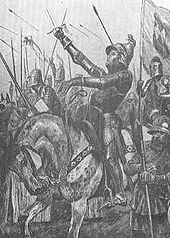 Henry "Hotspur" Percy - He early acquired a great reputation as a warrior, fighting against the Scots and the French. He fought against the Scottish forces of James Douglas, 2nd Earl of Douglas at the midnight Battle of Otterburn in August, 1388 and was captured, but later ransomed. Harry joined with his father and helped depose King Richard II in favour of Henry of Bolingbroke, who later became King Henry IV. He also was the co-commander with his father in the Battle of Humbleton Hill. Later, with his paternal uncle Thomas Percy, Earl of Worcester, he led a rebellion against Henry IV in 1403, forming an alliance with the Welsh rebel, Owain Glyndŵr, kinsman of Henry VIII. Before they could join forces, Hotspur was defeated and killed at the Battle of Shrewsbury when he raised his visor to get some air (as he was wearing plate armour which restricted air circulation) and was immediately hit in the mouth with an arrow and killed instantly. Henry "Hotspur" Percy - He early acquired a great reputation as a warrior, fighting against the Scots and the French. He fought against the Scottish forces of James Douglas, 2nd Earl of Douglas at the midnight Battle of Otterburn in August, 1388 and was captured, but later ransomed. Harry joined with his father and helped depose King Richard II in favour of Henry of Bolingbroke, who later became King Henry IV. He also was the co-commander with his father in the Battle of Humbleton Hill. Later, with his paternal uncle Thomas Percy, Earl of Worcester, he led a rebellion against Henry IV in 1403, forming an alliance with the Welsh rebel, Owain Glyndŵr, kinsman of Henry VIII. Before they could join forces, Hotspur was defeated and killed at the Battle of Shrewsbury when he raised his visor to get some air (as he was wearing plate armour which restricted air circulation) and was immediately hit in the mouth with an arrow and killed instantly.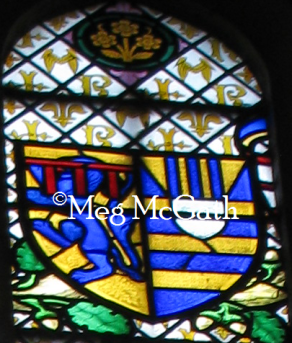
Warkworth Castle (pictured right) is a ruined, although reasonably well preserved castle, situated in Warkworth, Northumberland, England on a defensive mound in a loop of the River Coquet. The castle was home to "Hotspur". It was first granted to the Percy family through Henry de Percy, Lord of Alnwick. Under the Percys, additional building work took place, including the fourteenth century keep. However, in the rebellion of 1403, the castle fell to the King's cannon, suffering damage to the curtain wall. The castle was forfeited to the Crown, in whose ownership it remained until Henry V restored it to the Percy family. It was again forfeited to the King, during the Wars of the Roses and passed briefly into the hands of John Neville (brother of Warwick the Kingmaker) but again returned to the Percys in 1470. The Percys sided against Elizabeth I in the so called Rising of the North, an uprising of the northern earls which began in 1569. Thomas Percy, 7th Earl of Northumberland was executed in 1572 and the castle was pillaged by royal servants. The castle fell into long-term disrepair, being further damaged by the Parliamentary forces that were garrisoned there in 1648 and then used as a source of building materials for other houses in the later 17th century. |
Sir John of Wolfhall
Seymour
(1400-1464)
Father of
Sir John II Seymour
| Isabel Williams
(?-1485)
Mother of
Sir John II Seymour
| Lord John Clifford
7th Baron Clifford (1388-1422)
&
Father of
Mary Clifford
| Lady Elizabeth Percy
Baroness Percy
Countess of Northumberland
(1390-1437)
Mother of
Mary Clifford
| William Darrell of Littlecote Esq. (1384-1461)
&
Elizabeth Calston (1400-1464)
Parents of
Sir George Darrell | Sir Robert Croker of Lineham
(1401-1506)
&
Elizabeth Fortescue
(?-?)
Parents of Elizabeth Crocker
| John Stourton, 1st Baron
(?-1462)
Descendant of the Beauchamps and John of England
&
Margery Wadham
(?-?)
Parents of Margaret Stourton | Sir Roger Wentworth
of Nettlestead (1397-1452)
&
Margery Despencer (1397-1478)
Parents of
Sir Philip Wentworth | Sir John Saye (II)
(?-?)
&
Maud
(?-?)
Parents of
Sir
John Say (III)
| Sir Lawrence Cheney of Fen Ditton
(1396-1461) &
Elizabeth Cockayne (1404-?)
Parents of
Lady Elizabeth Cheney
|
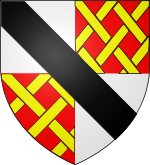 Margery Despencer was the daughter of Philip le Despencer, 2nd Baron le Despencer and his wife Elizabeth Tiptoft, daughter of Robert Tiptoft (Lord Tiptoff) and Margaret Deincourt. As the only child of Philip, she inherited his title and was Baroness Despencer in her own right. She married firstly John de Ros, 8th Baron de Ros. He died without heir and Margery went on to marry Sir Roger Wentworth, son of John Wentworth of North Elmsall and Elizabeth Beaumont. The Despencer line descended from Hugh le Despencer, Earl of Winchester and his wife Isabella de Beauchamp, daughter of William de Beauchamp, 9th Earl of Warwick and Maud FitzJohn. Both Hugh the Elder and the Younger Despencer would be executed by Isabella of France. Margery Despencer was the daughter of Philip le Despencer, 2nd Baron le Despencer and his wife Elizabeth Tiptoft, daughter of Robert Tiptoft (Lord Tiptoff) and Margaret Deincourt. As the only child of Philip, she inherited his title and was Baroness Despencer in her own right. She married firstly John de Ros, 8th Baron de Ros. He died without heir and Margery went on to marry Sir Roger Wentworth, son of John Wentworth of North Elmsall and Elizabeth Beaumont. The Despencer line descended from Hugh le Despencer, Earl of Winchester and his wife Isabella de Beauchamp, daughter of William de Beauchamp, 9th Earl of Warwick and Maud FitzJohn. Both Hugh the Elder and the Younger Despencer would be executed by Isabella of France. |
Sir John II Seymour
Sheriff of Wiltshire
(1427-1463)
Father of Sir John III Seymour
| Elizabeth Croker
(1436-1472)
Mother of Sir John III Seymour
| Sir George Darrell of Littlecote
(1419-1474)
His second wife was the great-grand aunt of Queen Catherine Parr
Father of Elisabeth Darrell
| Margaret Stourton
(1433-?)
Mother of Elisabeth Darrell
| Sir Philip Wentworth
(1424-1464)
Lancastrian supporter; beheaded by Yorkists.
Father of Sir Henry Wentworth | Mary Clifford (1416-1478)
Mother of Sir Henry Wentworth
| Sir John Say (III)
of Broxbourne
(?-1478)
Father of Anne Say
| Lady Elizabeth Cheney
(1422-25 Sep 1473)
Mother of Anne Say
| Elizabeth Cheney, later known as Elizabeth, Lady Tilney and Lady Say, was an English aristocrat, who, by dint of her two marriages, was the great-grandmother of Anne Boleyn, Jane Seymour, and Katherine Howard.
Elizabeth's first husband was Sir Frederick Tilney, ancestor to the Howard and Boleyn family. Sir Frederick died in 1445, leaving their young daughter Elizabeth Tilney as heiress to his estates.
Elizabeth Tilney married twice. Her first husband was Sir Humphrey Bourchier, grandson of Sir William Bourchier and Lady Anne of Gloucester, daughter of Thomas of Woodstock (youngest son of Edward III) and Eleanor de Bohun (descendant of Edward I), of whom was produced Lady Margaret Bryan nee Bourchier, mother of Sir Francis Bryan. Other issue included Elizabeth Bryan, wife of Sir Nicholas Carew.Elizabeth's second husband was Sir Thomas, Earl of Surrey (later 2nd Duke of Norfolk) by whom she had several children which included Lady Elizabeth Howard, mother of Queen Anne Boleyn and Lord Edmund Howard, father of Queen Katherine Howard. Elizabeth produced a total of nine children from both marriages.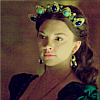 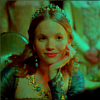 Shortly before 1 Dec 1446, Elizabeth Cheney married secondly to Sir John Say of Broxbourne, Speaker of the House of Commons, and a member of the household of King Henry VI. He was a member of the embassy, led by William de la Pole, 1st Duke of Suffolk which was sent to France in 1444 to negotiate with King Charles VII for the marriage between King Henry and Margaret of Anjou. Shortly before 1 Dec 1446, Elizabeth Cheney married secondly to Sir John Say of Broxbourne, Speaker of the House of Commons, and a member of the household of King Henry VI. He was a member of the embassy, led by William de la Pole, 1st Duke of Suffolk which was sent to France in 1444 to negotiate with King Charles VII for the marriage between King Henry and Margaret of Anjou.
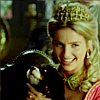 Her son William would father Mary Say who married Henry Bourchier, 1st Earl of Essex. Their daughter, Lady Anne, would go on to become the scandalous wife of Queen Catherine Parr's brother, Sir William Parr, 1st Marquess of Northampton. Her son William would father Mary Say who married Henry Bourchier, 1st Earl of Essex. Their daughter, Lady Anne, would go on to become the scandalous wife of Queen Catherine Parr's brother, Sir William Parr, 1st Marquess of Northampton.
Elizabeth had three younger sisters, Anne, wife of John Appleyard; Mary, wife of John Allington; Catherine, wife of Henry Barley, and one brother, Sir John Cheney who married Elizabeth Rempston. She also had two half-brothers by her mother's first marriage to Sir Philip Butler, a member of the noble Irish family, the Butlers of Ormond (ancestors of the Boleyn family).
Her paternal grandparents were Sir William Cheney and Catherine Pabenham, and her maternal grandparents were Sir John Cockayne, Chief Baron of the Exchequer and Ida de Grey, the daughter of Reginald Grey, 2nd Baron Grey de Ruthyn and Eleanor Le Strange of Blackmere.
| Sir John III Seymour
of Wolfhall
(1450 - 1491)
Father of
Sir John Seymour
| Elizabeth of Littlecote Darrell
(1451 - ?)
Mother of
Sir John Seymour
| Sir Henry Wentworth
of Nettlestead
4th Baron Despenser
Sheriff of Yorkshire
(1448 - 1501)
Father of
Margery Wentworth
| Anne Say (1457 - 1494)
Mother of
Margery Wentworth
| 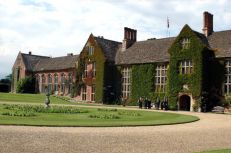 Elizabeth Darell was the daughter of Sir George of Littlecote Manor. Littlecote Manor was a Tudor style house near Wulf Hall, the home of the Seymour's. The original manor house with the deer park dates from around 1290 and was later rebuilt and extended around 1520. It was at Littlecote that Henry VIII courted Jane Seymour and they married at Wulf Hall nearby in 1536. Queen Elizabeth I was received at Littlecote in 1601 by which time further additions had been made, including The Long Gallery, and the early medieval hall had been converted into a Chapel. Elizabeth Darell was the daughter of Sir George of Littlecote Manor. Littlecote Manor was a Tudor style house near Wulf Hall, the home of the Seymour's. The original manor house with the deer park dates from around 1290 and was later rebuilt and extended around 1520. It was at Littlecote that Henry VIII courted Jane Seymour and they married at Wulf Hall nearby in 1536. Queen Elizabeth I was received at Littlecote in 1601 by which time further additions had been made, including The Long Gallery, and the early medieval hall had been converted into a Chapel.
Elizabeth's father married secondly Joan Haute/Hawte, a great-grand aunt of Queen Catherine Parr. Sir George Darrell and Joan's granddaughter was Elizabeth Darrell, maid-of-honour to Queen Katherine of Aragon and mistress of Sir Thomas Wyatt.
| Henry Wentworth was de jure 4th Baron Despenser. Anne Saye's mother Elizabeth was married firstly to Sir Frederick Tilney and had issue making her an aunt to Lady Elizabeth Boleyn nee Howard and Lord Edmund Howard. | 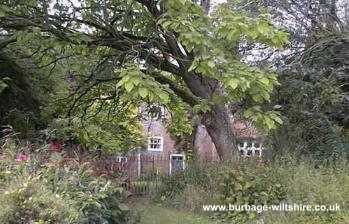 Wolfhall - The name is derived from a probable Saxon owner Ulph. Under the name Ulfela it was held at the Conquest by Ralph de Halville an officer of the King's. In the time of Henry III it was, together with the greater part of the district around, part of the fee of the Earl's Marshal under whom there were three landowners : Robert Beauchamp; Hugh Poer; Richard Berenger. Under Beauchamp, Henry Esturmi held Wulfhall in the third year of Edward I. By the sixth year of Edward III, Sir Roger de Stock had it. The Earl Marshall as owner was afterwards represented here, as at Bedwyn, by the Lords Stafford. The original building (of which very little remains) was the ancestral home of the Wardens of Savernake Forest. Originally the Esturmys then, the family continued until their heiress Maud brought it to the Seymour family. The Seymours lived here until abandoning it during the latter part of the 16th century. Wolfhall - The name is derived from a probable Saxon owner Ulph. Under the name Ulfela it was held at the Conquest by Ralph de Halville an officer of the King's. In the time of Henry III it was, together with the greater part of the district around, part of the fee of the Earl's Marshal under whom there were three landowners : Robert Beauchamp; Hugh Poer; Richard Berenger. Under Beauchamp, Henry Esturmi held Wulfhall in the third year of Edward I. By the sixth year of Edward III, Sir Roger de Stock had it. The Earl Marshall as owner was afterwards represented here, as at Bedwyn, by the Lords Stafford. The original building (of which very little remains) was the ancestral home of the Wardens of Savernake Forest. Originally the Esturmys then, the family continued until their heiress Maud brought it to the Seymour family. The Seymours lived here until abandoning it during the latter part of the 16th century.
By 1575, the Seymour family was living at its replacement, Tottenham Lodge (an old hunting lodge in Tottenham Park), about one mile away. The house was then used for servants but gradually became more dilapidated until the majority of it was demolished about 1665 to help restore the fire-damaged house at Tottenham Park.
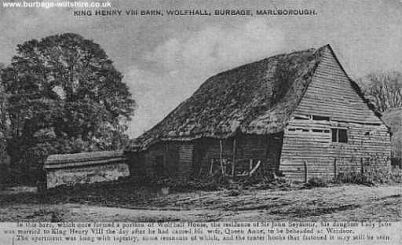 Local folklore has it that the wedding between Henry VIII and Jane Seymour took place in the ancient barn although more reliable sources place the event in London. It is probable however that the King hosted a celebratory wedding feast at the barn as records show that he visited the old house on a number of occasions. The barn survived into this century and reputedly, when it burned down in the 1920s, it still had the hooks on which the decorations and tapestries had hung. Local folklore has it that the wedding between Henry VIII and Jane Seymour took place in the ancient barn although more reliable sources place the event in London. It is probable however that the King hosted a celebratory wedding feast at the barn as records show that he visited the old house on a number of occasions. The barn survived into this century and reputedly, when it burned down in the 1920s, it still had the hooks on which the decorations and tapestries had hung.
During Edward VI's reign his uncle (later made the duke of Somerset) was Lord Protector until being beheaded for treason. It was during this period that the family's fortunes and the house fell into decline although the former were to be revived during Elizabeth's reign.
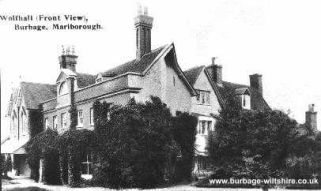 The current, largely Victorian building was being lived in by Lord Frederick Bruce when the photos were taken. During lord Bruce's tenancy he noticed a small stained glass window commemorating Henry and Jane. It is believed to be contemporary of the period and was moved to the chancel of Great Bedwyn's church where it can still be seen. The Bruces, and then the Brudenell-Bruces, succeeded Seymours to the Wardenship via the female lines. The current warden is the Earl of Cardigan, son and heir of Michael Sidney Cedric Brudenell-Bruce, the 8th marquess of Ailesbury. The current, largely Victorian building was being lived in by Lord Frederick Bruce when the photos were taken. During lord Bruce's tenancy he noticed a small stained glass window commemorating Henry and Jane. It is believed to be contemporary of the period and was moved to the chancel of Great Bedwyn's church where it can still be seen. The Bruces, and then the Brudenell-Bruces, succeeded Seymours to the Wardenship via the female lines. The current warden is the Earl of Cardigan, son and heir of Michael Sidney Cedric Brudenell-Bruce, the 8th marquess of Ailesbury. | 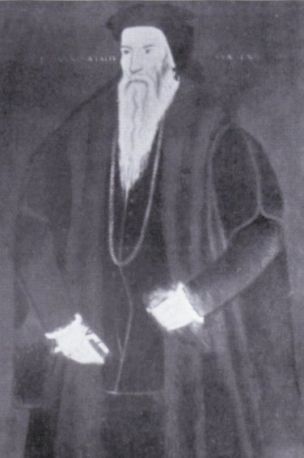 |
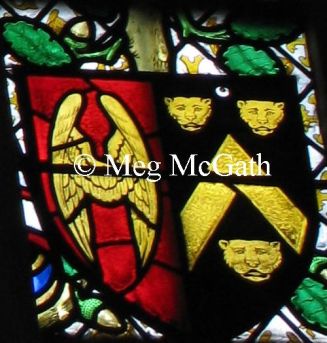
| Sir John Seymour (IV)
b. 1474 - d. 21 December 1536
The Seymours were an old and noble family. The Seymours were a family of country gentry who, like most holders of manorial rights, traced their ancestry to a Norman origin. One or two had been knighted in the wars of France, but their names had never emerged from the herald's visitation-rolls into historical celebrity. They increased their boundaries by fortunate alliances with heiresses, and the head of the family married into a collateral branch of the lordly line of Beauchamp. After that event, two instances are quoted of Seymours serving as high sheriff of Wiltshire. John was a member of the English gentry and a courtier to King Henry VIII, is best known for being the father of the king's third wife, Jane Seymour.
They lived in Wulfhall, outside Savernake Forest, in Wiltshire. John was commander during the suppression of the insurrection by the Cornish rebels in 1497, and during the French wars. He was made Knight Baronet by King Henry VIII in 1513. John was High Sheriff of Somerset, Sheriff of Dorset, Somerset, and Wiltshire. Five of the seven Seymour children achieved prominence at the royal court— Edward, Thomas, Jane, Henry, and Elizabeth. Seymour's second daughter, Elizabeth, was married firstly to Gregory Cromwell, son of Henry's new chief minister, Thomas Cromwell, and secondly to John Paulet, 2nd Marquess of Winchester.
Sir John Seymour was the cause of scandal when he embarked on a love affair with his daughter-in-law, Catherine Fillol, first wife of Edward Seymour. When it was discovered, the marriage to his son was annulled, their children declared bastards, since their legal grandfather might have been their biological father, and Catherine was imprisoned in a local convent. The scandal damaged the Seymour family's reputation for many years afterward. A proposed marriage between Jane Seymour and William Dormer was rejected by the Dormers partially due to the scandal and because of the family's less-than-noble pedigree.
The Seymour side of the family was distantly descended from William Marshal, 1st Earl of Pembroke.
The Seymours reached the peak of their influence in the sixteenth century, when Jane Seymour became the third wife of King Henry VIII. Their son became Edward VI and ruled England from 1547 to 1553. At the beginning of Edward's reign, he was nine years old and his eldest uncle, Edward Seymour, 1st Duke of Somerset, was Lord Protector of England, while another uncle, Thomas Seymour, 1st Baron Seymour of Sudeley, married Henry VIII's widow, Catherine Parr; both Edward and Thomas Seymour were executed for treason after the Seymour's put Lady Jane Grey on the throne. Edward, who was young and surrounded by men who were looking to advance politically, was used as somewhat of a pawn by his uncles. They did not want Lady Mary to become queen due to her strong belief in the 'old religion', Catholicism.
Lady Jane favoured the Protestant religion as the Seymour's and Edward VI had been brought up with. Lady Jane Grey was a granddaughter of Princess Mary Rose Tudor (Princess Margaret Tudor in the series) and Charles Brandon, Duke of Suffolk through their daughter Lady Frances Brandon, Duchess of Suffolk.
Seymour died on 21 December 1536. By royal custom, his daughter Queen Jane did not attend the funeral. | Margery Wentworth
b. 1478 - d. October 1550
Margery was born to Henry Wentworth and Anne Saye. Anne Saye was briefly married to Sir Frederick Tilney. Their marriage produced Elizabeth Tilney. Thus, through her mother, Margery's first cousins were Elizabeth Howard, Countess of Wiltshire and Lord Edmund Howard, parents to two other wives of Henry VIII, Anne Boleyn and Katherine Howard, respectively.
Although Lady Seymour may have been at court from time to time when Queen Katherine of Aragon was queen, she did not spend time there when her daughter Jane was Queen of England or when her son Edward was Duke of Somerset and Lord Protector for her grandson, King Edward VI. She made her home at Wulfhall, even after it passed into the possession of her eldest surviving son on the death of Sir John. It was a small establishment, the usual staff consisting of forty-four menservants and seven servant women, two of the latter nurses for Edward Seymour’s children. When King Henry VIII visited Wulfhall for four days in August 1539, Margery and her grandchildren moved into nearby Tottenham Lodge to make room for the royal party. The king arrived with a retinue of 200 and on the Sunday of the visit the Seymours had to feed some 400 persons.
In September 1548, when her daughter-in-law, Catherine Parr, died in childbirth, some sources report that Margery temporarily joined the household of her son Thomas at Sudeley Castle to care for the newborn Mary Seymour. Others accounts have Thomas bringing the child to his brother’s house in London. In letters written at this time to Lady Jane Grey’s parents, in the hope of having Lady Jane returned to his guardianship, Thomas Seymour assured them that he would keep his late wife’s household intact and that his mother take charge of it and treat young Lady Jane as if she were her own daughter. Lady Jane thereafter went to live at Seymour Place, Thomas Seymour’s London house, and one must suppose that Lady Seymour was there also. Only six months later, however, Thomas was executed for treason and his baby daughter was sent to live with Catherine Willoughby, Duchess of Suffolk (Catherine Brandon). It is difficult to imagine Margery Seymour’s feelings at that time, especially when it was her older son, Edward, who had sent Thomas to his death. Margery did not live long enough to see Edward executed in his turn, but by the time she died, she must have known that he had many enemies. When he attempted to give her a state funeral, claiming it was her right as the king’s grandmother, the Privy Council refused permission, some say simply to spite the much despised Lord Protector.
She was also known as a muse for the poet, John Skelton, as was Lady Elizabeth Boleyn nee Howard, mother of Henry's second queen - who, like Margery, was considered a very great beauty.
Through Margaret, Jane Seymour, a descent from the blood-royal of England was claimed from an intermarriage with a Wentworth and a supposed daughter of Hotspur and Lady Elizabeth Mortimer, grand-daughter to Lionel Duke of Clarence. Few persons dared dispute a pedigree with Henry VIII, and Cranmer granted a dispensation for nearness of kin between Henry VIII and Jane Seymour -- rather a work of supererogation, since the parties could not be related within the forbidden degree. Although the royal kindred appears somewhat doubtful, yet it is undeniable that the sovereign of England gained by this alliance one brother in-law who bore the name of Smith, and another whose grandfather was a blacksmith at Putney. | born c. 1507-1509* - died October 24, 153 *Antonia Fraser puts Jane's birth at 1509, Elizabeth Norton puts her birth
at late 1507 to late 1508, but does not rule out 1509. | |
